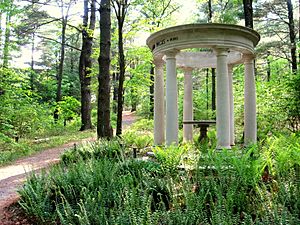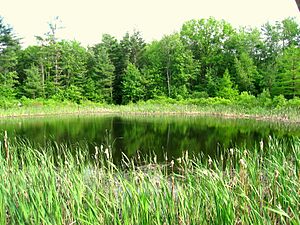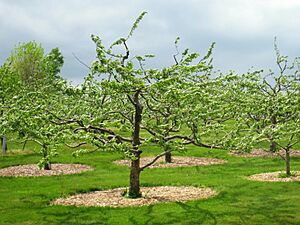Tower Hill Botanic Garden facts for kids

Secret Garden
|
|
| Established | 1986 |
|---|---|
| Location | 11 French Drive Boylston, MA |
| Type | Botanic Garden |
| Nearest parking | On site (no charge) |
The Tower Hill Botanic Garden is a huge garden and tree collection covering 171 acres. It's located in Boylston, Massachusetts, which is about 8 miles (13 km) north of Worcester. This special place has 17 different gardens, natural woodlands, and many miles of trails for walking.
It was started in 1986 by the Worcester County Horticultural Society. This society is one of the oldest groups in the U.S. that focuses on growing plants. Their main office is right here at Tower Hill.
The main goal of Tower Hill Botanic Garden is to "inspire the use and appreciation of horticulture to improve lives, enrich communities and strengthen commitment to the natural world." This means they want to show people how amazing plants are and how gardening can make our lives better. They also want to help us care for nature.
Contents
- What Can You See at Tower Hill?
- Amazing Gardens and Plant Collections
- The Entry Garden: A Welcoming Display
- The Winter Garden: Beauty in Cold Weather
- The Orangerie: A Warm Home for Tropical Plants
- The Limonaia: Home of Lemon Trees
- The Cottage Garden: Ideas for Your Home Garden
- The Lawn Garden: A Green Oasis
- The Secret Garden: A Hidden Gem
- The Inner Park: Nature and Art Combined
- Pliny's Allée: A Walk Among Oaks
- The Vegetable Garden: Fresh and Unusual Produce
- The Systematic Garden: Learning About Plant Families
- The Wildlife Garden: A Home for Animals
- The Wildlife Refuge Pond: A Watery Habitat
- The Moss Steps: A Green Carpet
- The Court: A Garden for Everyone
- The Asian Woods: Plants from Far Away
- The Field of Daffodils: A Burst of Spring Color
- Amazing Gardens and Plant Collections
- Special Plant Collections
- Cary Award: Promoting Great Plants
- See also
What Can You See at Tower Hill?
The Stoddard Education and Visitors Center is the main building where visitors start their adventure. Inside, you'll find the Farmer & The Fork Cafe, a Garden Shop, a theater, classrooms, and a library. The library has many books, magazines, and DVDs about plants, gardening, and botany.
Amazing Gardens and Plant Collections
Tower Hill Botanic Garden has many unique gardens, each with its own special theme or collection of plants. Here are some of them:
The Entry Garden: A Welcoming Display
This garden is the first one you see when you arrive. It has bright, colorful flowers that change with the seasons. It also shows off beautiful plants that are native to the area or can be eaten. It's designed to give you a great first impression of the garden.
The Winter Garden: Beauty in Cold Weather
This is a large courtyard garden, about 14,000 square feet (1,300 m2). It's surrounded by buildings and features plants that look amazing even in winter. In the middle, there's a formal pool with two bronze sculptures of native Eastern Box Turtles that act as fountains.
The Orangerie: A Warm Home for Tropical Plants
The Orangerie is a large greenhouse, about 4,000 square feet (370 m2). It's a mix of an old 18th-century style and a modern greenhouse. This is where Tower Hill keeps hundreds of tropical plants and blooming flowers warm during the winter.
The Limonaia: Home of Lemon Trees
This is another greenhouse that protects plants that can't handle cold weather. It's especially known for its collection of potted lemon trees.
The Cottage Garden: Ideas for Your Home Garden
This was the very first garden planted at Tower Hill in the 1980s. It's full of different trees, shrubs, flowers, and grasses. It shows how to combine colors and grow plants in different conditions, like shade or sun. It's a great place for home gardeners to get ideas.
The Lawn Garden: A Green Oasis
This garden has two large grassy areas bordered by over 350 types of ornamental trees and shrubs. Underneath these, you'll find beautiful flowers like peonies, day lilies, and iris, along with various ground covers.
The Secret Garden: A Hidden Gem
This is an enclosed, oval-shaped garden found on the lowest terrace of the Lawn Garden. It features two pergolas, a pool with a fountain, and many kinds of ornamental grasses and colorful annual flowers.
The Inner Park: Nature and Art Combined
This area is a garden of native plants and a woodland with mixed hardwood trees. It has pathways and beautiful architectural pieces, like the Peace Temple and other statues.
Pliny's Allée: A Walk Among Oaks
This is a long pathway lined with oak trees. Underneath them are shrubs that look especially beautiful in the autumn. At the end of the path, you'll find Pliny's Fountain, an old stone wellhead that shoots out water.
The Vegetable Garden: Fresh and Unusual Produce
This garden changes with the seasons and grows unique and old-fashioned vegetables, herbs, and annual flowers.
The Systematic Garden: Learning About Plant Families
This garden is designed like an Italian Renaissance garden and is a great way to learn about botany. Plants are arranged by their evolutionary relationships, showing how different plant species are connected. It's like a living encyclopedia of the Plant Kingdom, displaying plants from 26 different plant families.
The Wildlife Garden: A Home for Animals
This 0.5-acre (0.2 ha) garden has 3 miles (4.8 km) of woodland trails. It's a place where visitors can watch and learn about nature. It has both native and exotic plants that attract wildlife. There's even a screened building called the Bird House where you can watch birds without being bothered by insects. In winter, you can go cross-country skiing here.
The Wildlife Refuge Pond: A Watery Habitat
This 0.5-acre (0.2 ha) pond and its surrounding wetlands provide water and a home for wild birds, native amphibians, and fish. There's a rustic viewing pavilion where you can watch the wildlife.
The Moss Steps: A Green Carpet
These steps are covered in a beautiful carpet of moss. The limestone rocks used for the steps came from farm fields in Ohio. The area around the steps is planted with Mountain Laurel, native ferns, and wildflowers.
The Court: A Garden for Everyone
This garden space is designed to be easy for everyone to use, no matter their abilities. The plants are chosen for their interesting smells, textures, and colors. It has special movable planters, raised garden beds that are easy to reach, and a vertical "green wall" covered in plants.
The Asian Woods: Plants from Far Away
This section features plants from Asia and Eurasia that are similar to plants found in North America.
The Field of Daffodils: A Burst of Spring Color
This field is home to more than 25,000 daffodil bulbs. They create a stunning display of color when they bloom in late April, usually peaking between the third week of April and the first week of May.
Special Plant Collections
The Harrington Apple Orchard: A Taste of History
This orchard has a special collection of heirloom apples. It features 238 apple trees that represent 119 different apple varieties from before the 20th century. It's like a living museum of old apple types!
Cary Award: Promoting Great Plants
The Cary Award program helps promote excellent plants for gardens in New England. It's a team effort between Tower Hill Botanic Garden, the Massachusetts Horticultural Society, and other plant organizations. This award highlights ornamental plants that have proven to grow very well in the New England area.
See also
In Spanish: Jardín botánico Tower Hill para niños




